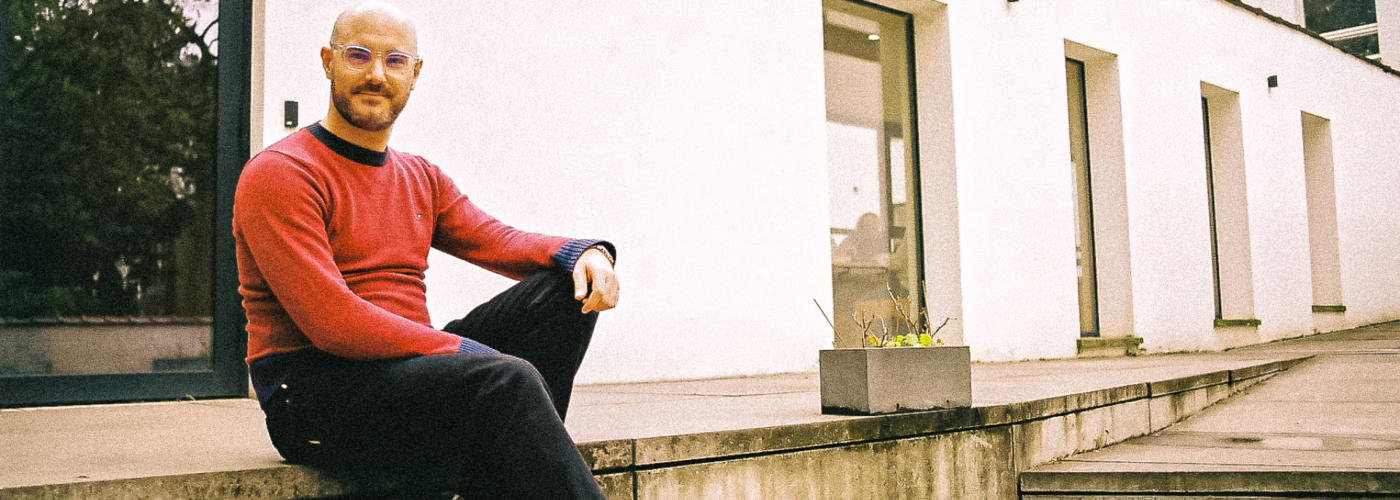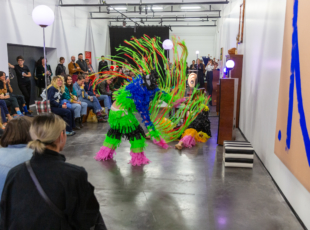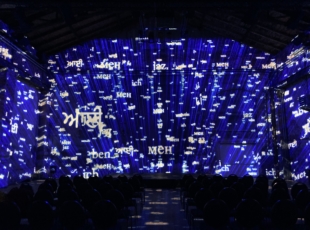Skan Triki, from reporter to motion designer, an eternal apprentice

Article author :
Trying to get a handle on the career pathways taken by the Belgo-Tunisian Skan Triki is a little like rummaging through a treasure chest. Mad about Greek mythology, Lebanese cuisine, the Marvel universe, a little less enthusiastic about the school system. A print media journalist in another life, this seasoned autodidact today heads his own motion design studio and is bringing to life visual effects of every type for France Télévision, NATO, Dune and the sequel to the Black Panther film. Not too shabby, all in all.
With a little hindsight, the location chosen for our meeting is not so lacking in significance. On this Friday afternoon, we are waiting for Skan at the European House of Authors. The MEDAA, for those in the know. The Brussels general headquarters of several ideally located copyright companies. As it turns out, we are pretty rapidly made aware that an author’s soul is lurking within this creative entrepreneur. ‘How did I fall into the visual industry? Let us say a little haphazardly, a random set of circumstances. I don’t have the qualifications for it, but that never intimidated my desire to learn.’ Taking in his very short spell at the Brussels Royal Conservatory of Music and at the Haute École ISFSC, Skan has never tarried for long on the school benches. But a good deal earlier than the image, it was writing and journalism which spurred the Brussels inhabitant on.
As laid-back as one can be, he retraces his path. ‘Now that I think about it again, it was Homer who led me to journalism. I have been reading him since I was a child. In the first chapter of The Iliad, an island is made mention of. It is told that Hephaestus was said to have learned the art of the forge there. I always wondered if this island actually existed. And at the age of 22, I finally took the time to provide an answer to my question.’ The island of Lemnos does indeed exist, 100 km from the Turkish border. When he published his first reportage in a travel magazine, which no longer exists today, he had very little idea that, several months later, he would be putting his pen to work for one of the flagship daily newspapers in French-speaking Belgium.




One job-shadowing internship later, plus a few mentors, and so it was that Skan Triki became a journalist at Le Soir. ‘My greatest pleasure was working away on long-format pieces’. It has to be said that the reporter has made carefully considered choices as to his sources of inspiration. On his smartphone, he takes us through the articles he always likes to keep close to hand. Lettres de province, considered to be the first press reportage, written by Jules Vallès, published in 1866 in Le Figaro, the complete set of the reportages by Joseph Kessel published in Le Matin, pieces by Françoise Giroux, and others.

In parallel with writing, Skan Triki almost imperceptibly tilted towards the image. First of all, by completely losing himself in the videos posted on the YouTube channel Kurzgesagt (which means ‘in a nutshell’ in German). ‘These animation videos tackle a whole host of contemporary issues, always by means of a hard-hitting narrative thread. I was fascinated by the format, there had been nothing like it at all at that time. The graphics, the animations, the voices, and so on.’ Inspired, once more, by the astute team of YouTubers putting out these videos, another tangled turn of events led him to produce a computer graphics investigation following the Brussels attacks for the Le Nouvel Obs. ‘It’s a bit of a cliché, but I literally spent my nights learning motion design in my bedroom. And in terms of skills, I had very little to go on. I very quickly learned to tinker around with Photoshop, because a mate had cracked the programme on his dad’s computer, but that’s it.’
Once I have explored all the possibilities, I can never keep doing the same projects for too long. Learning is a vital need.
Getting a foot in the door, as they say. Skan Triki takes an inexhaustible interest in developing his motion designer know-how. He contributes to the automation and the designs for the post-production work of numerous videos for institutions and other media, be they national, European, even international at times. The RTBF, NATO, L’Echo, RTS, France Télévision, etc. ‘I have realised that I prefer it when the facts are related visually rather than in the written word. In my opinion, there is increased potential to have an impact on the general public.’
He consecutively tried his hand at several additional professions – it is impossible to provide you with an exhaustive list; a motion design teacher at a Brussels communications and journalism school, a multimedia manager for the first Belgian continuous news channel, LN24, and finally creating his own studio, Motion Sense. ‘Once I have explored all the possibilities, I can never keep doing the same projects for too long. Learning is a vital need.’
When he talks to us about his most recent collaborations, we cannot help but crack a mischievous smile, given that this desire to notch up domains and skills seeps from every pore of his being. On a quest for challenges, Skan Triki gradually turned towards an industry he still had no knowledge of, that of special effects. And, by the same token, cinema. He got in touch with the Perception and Territory studios. Creation agencies based in the States and boasting international renown, in particular for their special effects work for the feature length films produced by the Marvel universe. On Skan’s portfolio you will come across his creations for Black Panther: Wakanda Forever and Ant-Man and the Wasp: Quantumania. ‘In comparison with motion design, the special effects, its goldsmithing.’
Production, apprenticeships and private life
From day to day, the routine of the Brussels inhabitant adapts to the rhythm of creation and production on the one hand, to the planning of a disciplined training programme on the other, and to a private life he especially has no wish to cut back on. Whilst he is grateful to the linchpins he has leaned on to develop his vision of entrepreneurship, the need for initiative, and the concept of failure as well, Skan now welcomes interns to his motion design studio. Interns with whom he attempts to invert the hierarchy based on the all-knowing teacher. ‘When I have an intern learning at the studio, I don’t want them to work for me, but to work for themselves. I always ask them: what do you want to do, where do you want to go, professionally speaking? By doing so, I hope to be the teacher I never had.’
On observing the rigour by which he details and logs his learning processes – a kind of Excel spreadsheet in which he sets in order and preserves his advances in the acquisition of new skills, the use of new programmes or plugins of every type – we ask him what he would like to add to them if his days exceeded the 24 hours allocated to each mortal being. ‘The piano, maybe? I played it throughout my childhood, with music theory courses, of course. When I think about it, my music and rhythm apprenticeship, on top of my relationship with writing, all of that is found in motion design.’
Skan may well have distanced himself from it in terms of words, yet he never remains very far from the world of media and journalism. And even if his diary is more than full, he does admit to it: ‘Sometimes, I miss the press. I would very much like to be the journalist I always dreamed of being, to produce computer graphics investigations and work for Le Monde. If I had the opportunity to do some freelance work for them one day, I would make some room for it, that’s for sure.’
A story, projects or an idea to share?
Suggest your content on kingkong.
also discover

From Belgium to Japan, the new territories of creative digital creativity

Stereopsia, the key European immersive technologies hub

The Centre Wallonie-Bruxelles: a billion blue blistering harmonies


